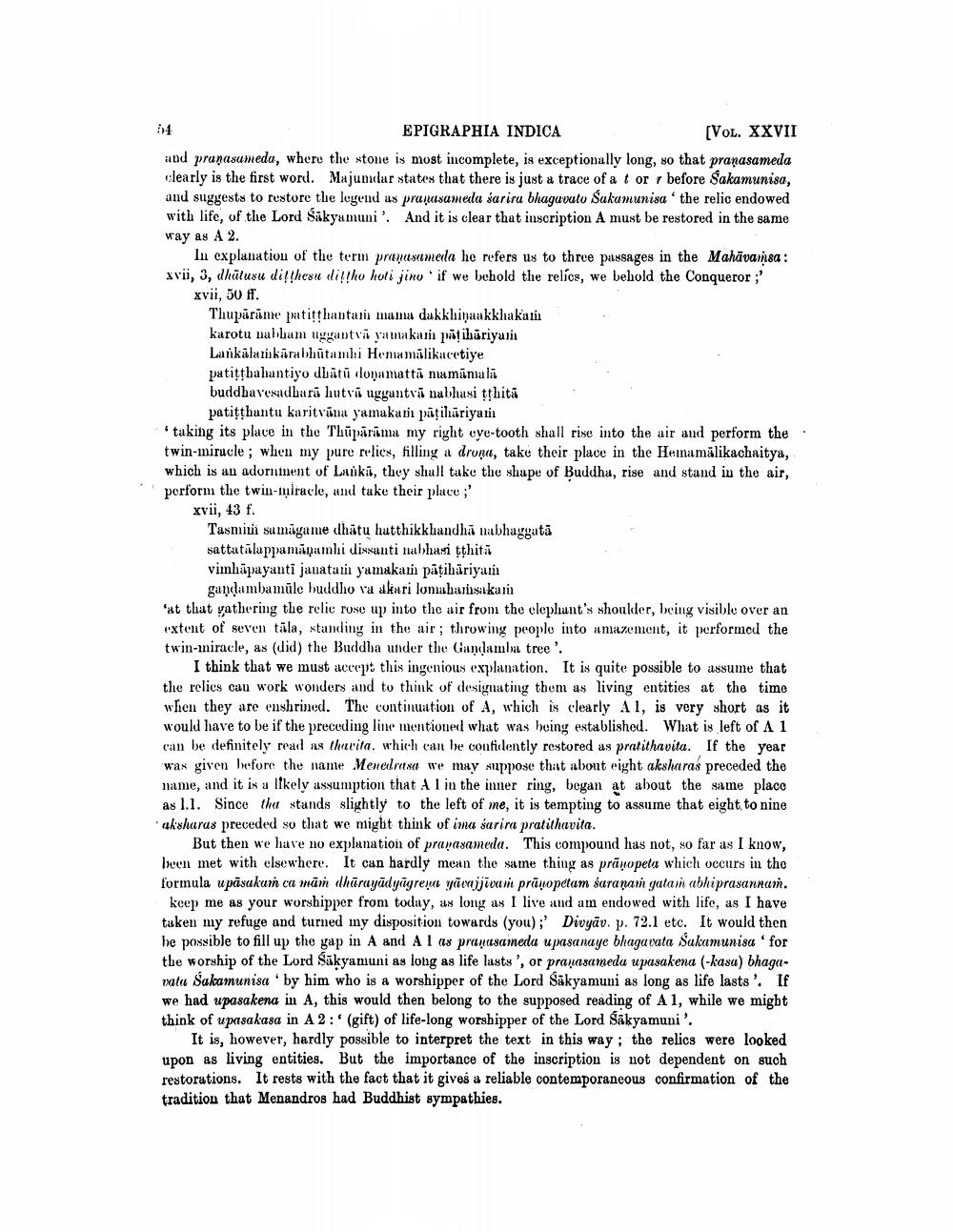________________
54
EPIGRAPHIA INDICA
[VOL. XXVII and praṇasameda, where the stone is most incomplete, is exceptionally long, so that pranasameda clearly is the first word. Majumdar states that there is just a trace of a t or r before Sakamunisa, and suggests to restore the legend as pranasameda sarira bhagavato Sakamunisa the relic endowed with life, of the Lord Sakyamuni'. And it is clear that inscription A must be restored in the same way as A 2.
In explanation of the term pranasameda he refers us to three passages in the Mahāvamsa: xvii, 3, dhatusu difthesu dit!ho hoti jino if we behold the relics, we behold the Conqueror ;' xvii, 50 ff.
Thupäräme patiṭṭhantam mama dakkhinaakkhakam karotu nabham uggantva yamakam patihariyam Lankalamkarabhūtambi Hemamalikacetiye patitthalantiyo dhātā logamattā namānal buddhavesadhara hutva uggantva nabhasi ṭṭhitä patiṭṭhantu karitvana yamakam patihariyam
taking its place in the Thuparama my right eye-tooth shall rise into the air and perform the twin-miracle; when my pure relics, filling a drona, take their place in the Hemamalikachaitya, which is an adornment of Lanka, they shall take the shape of Buddha, rise and stand in the air, perform the twin-miracle, and take their place;'
xvii, 43 f.
Tasmin samagame dhatu hatthikkhandha nabhaggatā sattatalappamanamhi dissanti nabhasi tthita vimhapayanti janatam yamakam pāțihariyam
gandambamule buddho va akari lomahamsakam
'at that gathering the relic rose up into the air from the elephant's shoulder, being visible over an extent of seven tala, standing in the air; throwing people into amazement, it performed the twin-miracle, as (did) the Buddha under the Gandamba tree'.
I think that we must accept this ingenious explanation. It is quite possible to assume that the relics can work wonders and to think of designating them as living entities at the time when they are enshrined. The continuation of A, which is clearly A1, is very short as it would have to be if the preceding line mentioned what was being established. What is left of A 1 can be definitely read as thavita, which can be confidently restored as pratithavita. If the year was given before the name Menedrasa we may suppose that about eight aksharas preceded the name, and it is a likely assumption that A 1 in the inner ring, began at about the same place as 1.1. Since the stands slightly to the left of me, it is tempting to assume that eight to nine aksharas preceded so that we might think of ima sarira pratithavita.
But then we have no explanation of prayasameda. This compound has not, so far as I know, been met with elsewhere. It can hardly mean the same thing as praopeta which occurs in the formula upasakuṁ ca māṁ dhūrayādyāgrena yāvajjivam pravopetam saranam gatam abhiprasannaṁ. keep me as your worshipper from today, as long as I live and am endowed with life, as I have taken my refuge and turned my disposition towards (you);' Divyav. p. 72.1 etc. It would then he possible to fill up the gap in A and A 1 as pranasameda upasanaye bhagavata Sakamunisa 'for the worship of the Lord Sakyamuni as long as life lasts', or prapasameda upasakena (-kasa) bhagavata Sakamunisa by him who is a worshipper of the Lord Sakyamuni as long as life lasts'. If we had upasakena in A, this would then belong to the supposed reading of A 1, while we might think of upasakasa in A 2: (gift) of life-long worshipper of the Lord Sakyamuni'.
It is, however, hardly possible to interpret the text in this way; the relics were looked upon as living entities. But the importance of the inscription is not dependent on such restorations. It rests with the fact that it gives a reliable contemporaneous confirmation of the tradition that Menandros had Buddhist sympathies.




